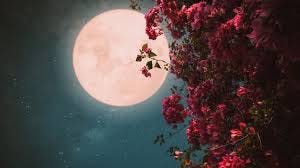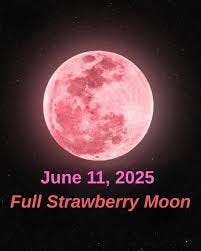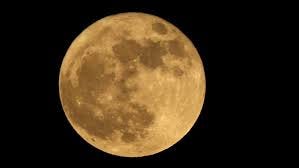🌕 The 2025 Strawberry Moon: A Low-Hanging Wonder 18.6 Years in the Making
This year’s full moon is set to be the lowest in the sky since 2006
🌕 The 2025 Strawberry Moon: A Low-Hanging Wonder 18.6 Years in the Making
This year’s June full moon will hug the horizon, eclipse a red supergiant, and illuminate centuries of history, tradition, and cosmic rhythm.
Every year in June, the full moon rises with a romantic name: the Strawberry Moon—a soft nod to the short-lived strawberry harvests once tracked by Native American tribes across the Northeast.
But on June 11, 2025, the Strawberry Moon will do more than mark the start of summer. It will usher in a celestial moment we haven’t seen in nearly two decades.
This year’s full moon is set to be the lowest in the sky since 2006, part of a rare lunar cycle known as a major lunar standstill. And if that weren’t enough, the moon will drift close to—or even pass in front of—Antares, the glowing red heart of the Scorpius constellation.
The result? A golden orb, barely rising above the treetops, casting honey-colored light and cosmic perspective for those lucky enough to be watching.
Let’s break down what makes this Strawberry Moon so extraordinary—and why it’s a moon worth remembering.
🌌 A Moon That Hugs the Horizon: The 18.6-Year Lunar Cycle
Every 18.6 years, the moon’s orbit tilts to its maximum declination, reaching its most extreme positions in the sky. This cycle, often invisible to casual observers, creates moments when the moon rises and sets farther north or south than usual—closer to the horizon, more elongated in arc, and deeply atmospheric in appearance.
This cycle is called the lunar nodal cycle, and when it peaks, we experience what astronomers refer to as a major lunar standstill.
The 2025 Strawberry Moon will be the lowest full moon for Northern Hemisphere viewers since 2006. It will rise and set with a shallow arc, making it appear larger, more golden, and strikingly close to Earth—a visual trick caused by the thicker atmosphere it passes through when it’s low on the horizon.
It’s the kind of sight that reconnects you to scale—reminding you just how small we are compared to the slow-turning clockwork of the cosmos.
🍓 The Moon With Many Names—and Even More Meaning
While “Strawberry Moon” is the most familiar name for June’s full moon in the U.S., especially among Native American and colonial traditions, it’s not the only one.
In European folklore, the June full moon has been called:
• The Mead Moon – after the fermented honey drink brewed in early summer
• The Honey Moon – associated with sweetness and new beginnings
• The Rose Moon – referencing the bloom of summer roses
These names all echo fertility, celebration, and natural abundance. In fact, the term “honeymoon”—used today to describe the first month after a wedding—is widely believed to have originated from this lunar timing, when weddings were held and honey wine flowed freely.
So when you look up at the Strawberry Moon this year, you’re not just witnessing a light in the sky. You’re touching a thread woven through centuries of human joy, harvest, and hope.
🌟 The Moon and the Red Giant: A Celestial Double Feature
June’s moon isn’t just about Earthly tradition—it comes with an astronomical bonus.
On the evening of June 10, 2025, as the Strawberry Moon rises, it will appear very close to Antares, a red supergiant star 550 light-years away, famous for its intense crimson hue. Antares is sometimes called the “heart of the scorpion” and is one of the brightest stars in the night sky.
But here’s the rare twist:
If you’re watching from parts of Oceania (including Australia and New Zealand), the moon will pass directly in front of Antares in a brief but dramatic occultation, making the massive star vanish for a few minutes.
This visual “blinking out” of a star by the moon is a celestial rarity—and for Antares, a particularly poetic clash of light and shadow, old and new.
For most other parts of the world, Antares will hover just to the upper right of the moon, creating a brilliant visual pairing for skywatchers with binoculars or long-exposure cameras.
🟠 No, It’s Not Pink—But Here’s Why It Looks Golden
Despite the name, the Strawberry Moon won’t be pink.
That pink hue is poetic, not literal. What you’ll see instead—especially at moonrise—is a deep gold or amber color. This is due to Rayleigh scattering, the same phenomenon that makes sunsets red.
As the moon rises low on the horizon, its light travels through more of Earth’s atmosphere. Blue and violet wavelengths scatter out, while longer red and yellow wavelengths pass through—leaving the moon bathed in warm tones.
This year, the effect will be even more pronounced due to the moon’s low altitude. It’s not an eclipse, not a trick—just the Earth showing off its filters.
🕓 When to Watch: Key Times and Tips
Want the best view? Here’s what you need to know:
• Peak Full Moon:
🗓️ June 11, 2025
⏰ 3:44 a.m. EDT (Exact full moon phase)
• Best Viewing Time:
🌄 Moonrise on the evening of June 10
That’s when the golden glow and horizon-hugging illusion will be most dramatic.
• What to Look For:
✨ A large, golden moon low on the horizon
🔴 Antares glowing nearby—or briefly disappearing if you’re in Oceania
📸 Bring a camera with a zoom lens or binoculars for enhanced detail
• Next Time This Happens:
📅 2043 — so this is, quite literally, a once-in-a-generation moment
🌍 What the Strawberry Moon Reminds Us
In a time when everything moves quickly—when news cycles spin and digital noise fills the air—moments like the 2025 Strawberry Moon ask us to pause.
They remind us that the Earth, the moon, and the stars keep dancing regardless of what we’re doing. They remind us that ancient traditions and astronomical mechanics are not separate, but part of the same cosmic story we’re all living through.
Whether you’re lying in a field, watching from your city rooftop, or waking up early with a child to share the wonder—this moon is for you.
It won’t be pink. But it will be magic.
📝 Mark your calendar. Charge your phone. Or better yet—leave it behind. The moon will rise whether we post it or not. But we may not see it like this again until 2043.







